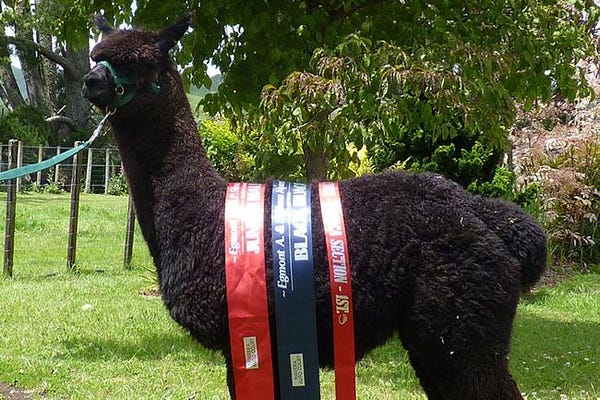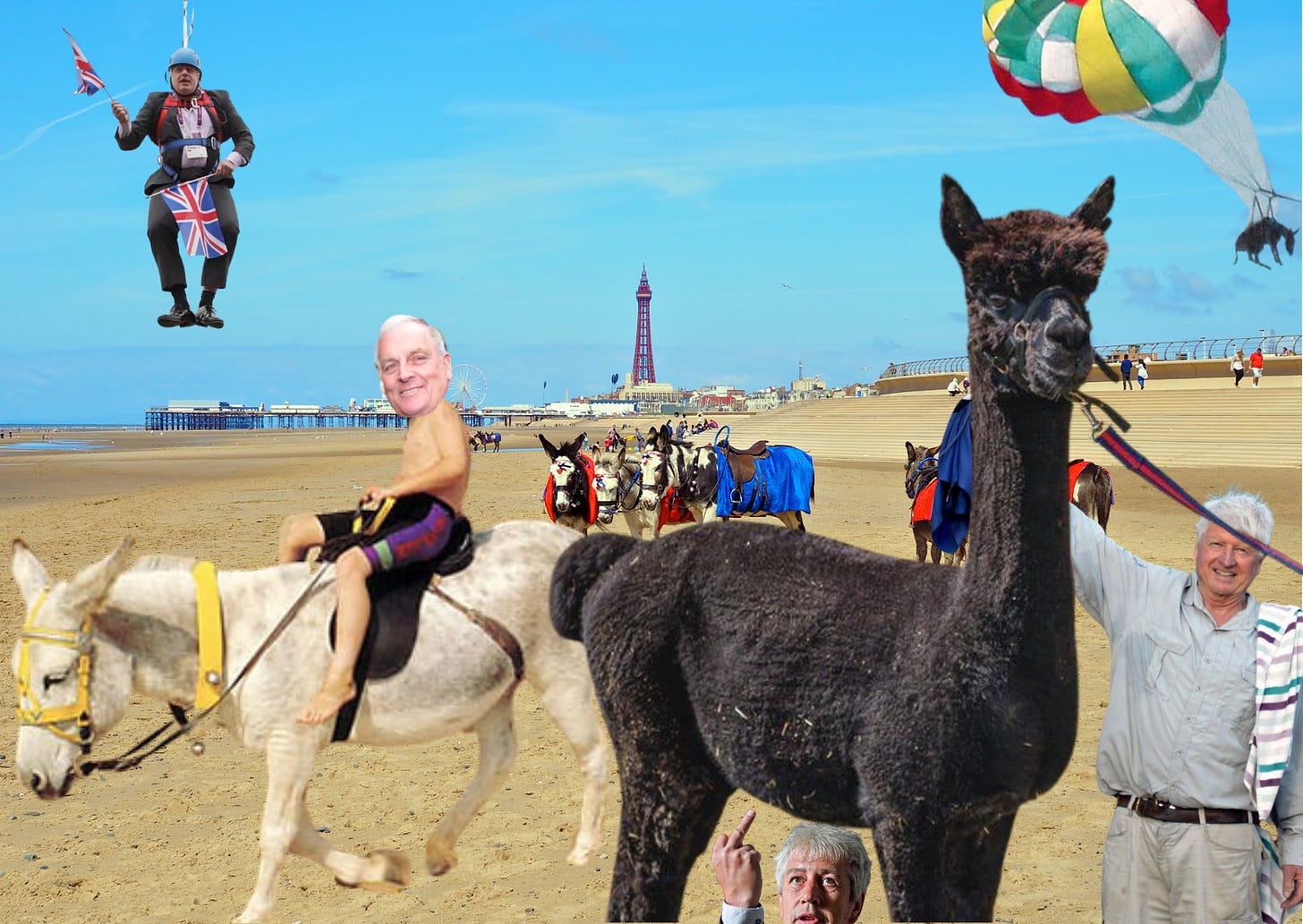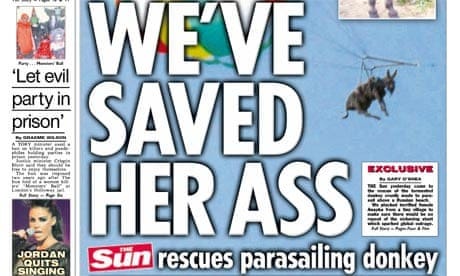Alpaca cheap tricks: Tabloid tears for Geronimo are the latest in the long line of manipulative creature-focused campaigns…
… just don’t expect them to do the same for humans in despair.
As editor of The Sun, Kelvin Mackenzie defamed Liverpool fans who died at Hillsborough, gloated about the deaths of 323 Argentine sailors on the Belgrano, and hounded gay people during the darkest years of the AIDS epidemic.
But he was always ready to defend a donkey. Because that is one of the tenets of tabloid journalism:
You can be as cruel as you like to human beings but you must reach ludicrous levels of lachrymosity when a cute animal is involved.
In 1987, a donkey called Blackie became the subject of a tabloid war between The Sun and The Daily Star. Both newsrooms got word via the Devon Donkey Sanctuary of a tradition in Villanueva de la Vera — a town 150 miles west of Madrid — where Shrove Tuesday was marked by having the fattest man ride a donkey through its narrow streets before it collapsed with exhaustion.
It was also suggested that villagers then jumped on the donkey and crushed it to death, but the claim was denied by the Spanish ambassador to London whose words were printed by The Sun under the headline It’s A Load Of Old Cojones*. The asterisk directed readers to a footnote that explained:
“That’s Spanish for bollocks.”
Sensing the chance for a stunt, both The Sun and The Star dispatched reporters to Spain on a mission to rescue Blackie, the donkey set to endure that year’s ceremony. The Star’s man near Madrid was Don Mackay while The Sun sent Hugh Wittow, who was riding high on a recent rash of scoops.
Wittow appeared to have won by getting there first, bagsying Blackie for £250 in pesetas, but he made the fatal error of entrusting the donkey to a double-dealing farmer overnight.
Mackay simply paid the man more, took possession of the donkey and stashed him in his hotel room until a flight back to Britain could be arranged. Stick It Up Your Punter! The Uncut Story of the Sun Newspaper recounts:
The Star reporter called his editor, Lloyd Turner, to report [that] everything was fine except for the terrible smell. “Don’t worry,” Turner replied, “The donkey will get used to it.”
The Star rubbed it in by repurposing The Sun’s infamous Gotcha!1 headline for its splash about ‘saving’ Blackie. The front page included a picture of the desirable donkey along with a receipt purporting to show ownership.
The Sun vainly clung to the fact that it had paid for Blackie first and, according to Stick It Up Your Punter, also attempted to bribe The Star hacks with £6,000 to hand him over. They declined. There then followed a typically unedifying row between the tabloids, which ended with The Star bringing Blackie back to Dover where there was a punch-up with a Sun hack.
Mackenzie had tried to spin the story as one of the ‘cruel’ Star separating Blackie from his pals in sunny Spain before okaying a plan to have a female donkey waiting for him in England. But The Star drove straight past the welcoming party and hit back at MacKenzie’s antics by revealing that Coco, the filly The Sun had found for Blackie was, in fact, a fella.
In 2010, The Sun — this time in competition with The Mirror — found another donkey in distress to tug its readers’ heartstrings. On 21 July 2010, The Sun reported on a donkey forced to parasail as part of a marketing stunt for a Russian resort under the headline Drop the red donkey while The Mirror ran the same agency story with the line Someone needs their ass kicking.
By Friday of the same week, The Sun had purchased Anapka and told its readers beneath a painful headline (Eeyore not winging anymore) that she would “NEVER be forced to parasail again." The no doubt delighted donkey was pictured with the paper’s Russian correspondent Anna Shlyakhtenko, being fed “apples, cucumbers and sweetcorn”.
The Sun made sure to remind readers that Anapka was trotting in the hoof steps of Blackie, who lived out his days at the Devon Donkey Sanctuary but neglected to mention that The Star beat it to the rescue.
Russia Today, the Russian state-back news channel, also claimed that The Sun had purchased a ‘fake’ donkey and the ‘real’ donkey was living at the Kremlin:
A follow-up story on Anapka in The Sun claimed that football manager Harry Redknapp would bring her to live at an animal sanctuary he was setting up. However, eight years later when Redknapp was appearing in I’m A Celebrity, the paper admitted that:
… Harry's animal sanctuary never came to fruition and talks with the government to bring her back to the UK fell through.
Anapka spent the remaining 6 months of her life at a sanctuary near Moscow where, The Sun assured its readers, “she spent the rest of her days in luxury.”
And this brings us to the story of Geronimo the alpaca, the cursed camelid facing almost certain death after two positive TB tests.
Stanley Johnson, holder of the ceremonial office of… checks notes… Prime Minister’s father and Sun ‘environmental correspondent’ — emphasis on the final syllable of the first word — has been all over the media defending the alpaca. Meanwhile Environment Secretary, farmer, and animatronic gnome figurine George Eustace and focus group choose your adventure story protagonist Keir Starmer have been united by their blood lust urge that Geronimo must die.
While the entire media has jumped on the silly season opportunity to debate the death penalty for alpacas, The Sun has unsurprisingly gone in hardest. On August 3, Rod Liddle’s column bore the screaming headline TUBERCULOSIS TEST TRAVESTY Save Geronimo! The alpaca facing death by bureaucrat’s bullet while the paper’s front page August 5th featured the alpaca’s owner Helen Macdonald and the hysterical line LAST STAND Geronimo the alpaca’s owner vows ‘I’ll take a bullet for him’ as jobsworths condemn him to death.
Seeing the opportunity to rail against “jobsworths” and “bureaucrats” — faceless and otherwise — Liddle wrote:
There are just two days left to save Geronimo the Alpaca.2 On Thursday the Men from the Ministry will be coming around with their rifles. And that will be the end of Geronimo – executed for a “crime” he didn’t even commit.
Geronimo lives on a farm in Gloucestershire with his doting owner, Helen MacDonald. He’s eight years old and comes from New Zealand. And he’s been under sentence of death for three years.
Now all his chances have run out and on Thursday he will face a bureaucrat’s bullet. It is a travesty of the law and should shame the agriculture minister, George Eustice.
Without even a vanity farm like his Sunday Times and Sun colleague Jeremy Clarkson, Liddle is far from an expert in farming or animal health. But he’s an expert cynic and he knows readers are ready to get very upset at the prospect of a cuddly animal being culled, even if they bought their paper in the same shop as the chops for Sunday lunch.
And, as is so often the case, there’s precedent for exactly this kind of media storm over a single ‘cute’ animal. In 2007, Shambo — a bullock living at the Skanda Vale monastery in West Wales — tested positive for TB. The monks there claimed that the order to slaughter him was a breach of their human rights and appealed to the courts.
The initial rulings went in their favour, suggesting that the Welsh government had not shown due regard to their human rights. But, the government appealed, and the ruling was overturned. The judges believed the minister had thought properly about the implications of culling Shambo and the order was carried out. The operation to take the bullock away was covered live on rolling news channels.
At post-mortem, it was discovered that Shambo did have TB lesions, though the absence of them would not have definitively proven that he had not been suffering from the disease either. The Farmers Union of Wales argued that the delay in slaughtering Shambo had put hundreds of other animals in the area at increased risk.
Another bullock, Bhakti, and a buffalo calf, Dakshini, were subsequently put down at Skanda Vale but the media circus had moved on and their deaths received no major press coverage.


In an informative thread comparing the Shambo story with Geronimo, Gareth Enticott, Reader in Human Geography at Cardiff University and an expert in animal disease, particularly bovine TB, writes:
Shambo’s case has similarities to Geronimo’s: In Geronimo’s case, the owner argued that the TB tests were unreliable. However, the courts are unlikely to intervene in a matter of scientific uncertainty as the judgment makes clear.
… so long as the Minister shows he/she weighs up the pros and cons of a course of action — in this case around TB testing — then they can follow their existing policy of test and slaughter.
Enticott notes that there have been successful appeals against negative tests but that they have been on procedure and not the basis of the science.
He cites the case of a dexter calf called Fern whose test was not correctly completed by the vet, a procedural mix up with blood samples from a pedigree bull called Hallmark Boxster, and a legal dispute over compensation for a Holstein cow called Ecstasy Journalist Roxie — valued at over £100,000 but deemed worthy of only £800 compensation by Defra — which led to a successful retest.
As Enticott also points out, Geronimo is merely being used as a vehicle for a long-running battle over the bovine TB policy. There are moral questions over “test and slaughter” but tabloid stories obscure those complex issues with the simpler emotions of “cute critter” and “one woman’s stand against the ministry”. Were Geronimo a little less photogenic and facing ‘the firing squad’ (there is no firing squad) in a busier time for news, it’s unlikely he’d make the front pages.

28,356 cattle were slaughtered due to TB infection in England between March 2020 and March 2021. But they were given names, backstories, and the backing of Chris Packham, Joanna Lumley, and Stanley Johnson. The Geronimo story is not about facts but feelings and the tabloid exploitation of them.
Vets who have to implement the test and cull regime on a daily basis have been discussing the case in private forums with increasing frustration. They are made to implement the public health regime all year round, with grim mundanity and no shortage of anger from farmers, but now something slightly more unusual — an alpaca — is at the heart of the story the media is once again interested.
The same papers that will blithely discuss removing ethnic minority status from Gypsy, Romany and Traveller people, shrug and sneer at people being deported to countries where they have never lived and publish icy cold editorials about the channel migrant ‘problem’, shed big salty tears for a single alpaca with a nice owner and a simple story of the mean men from the ministry to rail against.
I’m not desperate to see Geronimo’s demise — unlike Keir Starmer who seems so certain it’s like he saw focus group results and immediately cocked his shotgun — but I also cannot shake off the hyperbole of focusing on a single animal while countless stories of human suffering are ignored or crunched to down page insignificance.

It’s hard not to conclude that the simulation is glitching when Reuters publishes, with a straight face, the headline Doomed alpaca triggers outcry against British PM Johnson and opens its story with these paragraphs:
The fate of a doomed eight-year-old alpaca named Geronimo has triggered an outcry against British Prime Minister Boris Johnson after his government ordered the animal be put down because of positive tests for bovine tuberculosis.
The order to kill the alpaca prompted pleas from owner Helen Macdonald for Johnson and his wife Carrie to show mercy, prompting some celebrities to demand the prime minister swerve away from what they cast as a public relations disaster.
Despite the British press’ constant insistence that First Lady is an unelected power base, Carrie Johnson has no role in whether an alpaca is culled, and acting as though Boris Johnson is some kind of fat baby Commodus sitting in the colosseum ready to raise his thumb in mercy for Geronimo is just a further dismissal of even the illusion of a rules-based system.
We could have a serious debate on animal welfare, the fight against bovine TB, and our wider attitude to sentient life but that’s not what the British newspapers exist to do. Instead, they’re back on the old donkey ride, playing to the same Punch & Judy emotions that Kelvin Mackenzie appealed to back in the eighties.
And whatever happens to Geronimo, the media circus will move on quickly.
‘Gotcha’ was the headline used by Mackenzie for the front page revealing that the Royal Navy had sunk the Argentine cruiser, General Belgrano, during the Falkland War. It was derived from an exclamation by the paper’s ‘charming’ features editor Wendy Henry on hearing the news.
At the time of writing — 7 days after Liddle’s column was published — Geronimo is still in the land of the living.




